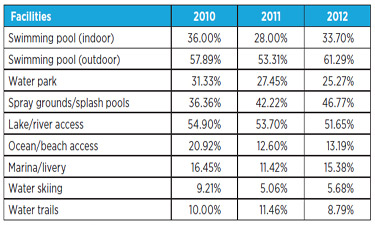 In whatever form, be it ocean, lake, river, pond, pool, water park, splash pad, or spray ground, water is a common resource that draws users to our parks and enhances our recreation. In the first week of July with temperatures in the 100s throughout the eastern U.S., any form of water was a relief. Since the Renaissance began in Europe in the 14th century and even in the earliest Chinese dynasties, both private gardens and public parks with clean, fresh water were prized places.
In whatever form, be it ocean, lake, river, pond, pool, water park, splash pad, or spray ground, water is a common resource that draws users to our parks and enhances our recreation. In the first week of July with temperatures in the 100s throughout the eastern U.S., any form of water was a relief. Since the Renaissance began in Europe in the 14th century and even in the earliest Chinese dynasties, both private gardens and public parks with clean, fresh water were prized places.
It is no different today. Public parks are often provided water features if they are not a natural part of the park setting. In the early 1900s, many public parks had beach access to rivers, lakes, streams, and oceans. By the late 1940s to the mid 1970s, outdoor pools were built by the thousands. Initially, they were a function of housing developments and homeowners’ associations and later of public parks. The late 1970s saw the beginning of the indoor swimming pool boom, which continues today, coupled with fitness and other programs and class activities. Water parks became the facility of choice in many locations by the mid 1980s, and the 1990s began the development of splash pads and spray grounds, which were less expensive to build and operate. The above table shows the current percentage indicating the incidence of various water facilities and resources.
These are aggregate percentages of responses from profiles created in each of the operating years indicated. Thus the three numbers for indoor swimming pools indicate that approximately one third of the departments that responded operate indoor pools. This may not be a high statistical confidence level, but it is probably a good indicator of the incidence of indoor pools operated by agencies.
Note that outdoor pools and lake/river access are both above the 50-percent level, and the incidence of spray grounds and splash pads is above 40 percent.
Save More on Aquatic Program Providers!
Did you know NRPA partners with top leading aquatic safety program providers?
As park and recreation agencies across the country examine ways to stay competitive and find efficiencies, NRPA member discount programs are a solution to help agencies operate effectively. We wanted to ensure that NRPA agencies had more choices and more flexibility, while still delivering access to state-of-the-art training courses and cutting-edge resources and tools.
NRPA has partnered with the American Red Cross, Ellis & Associates, and Starfish Aquatics Institute. Each has designed savings on their lifeguard training and swimming instruction programs exclusively for NRPA members. Our partnerships give members more opportunities to save on their total training costs. We encourage you to compare the significant savings on these aquatic programs!
NRPA is committed to collaborating in future partnerships to help provide members with a wide range of value-added offers and special savings. NRPA evaluates all discount opportunities to ensure that members get the maximum benefit.
Learn more about NRPA Member benefits.

